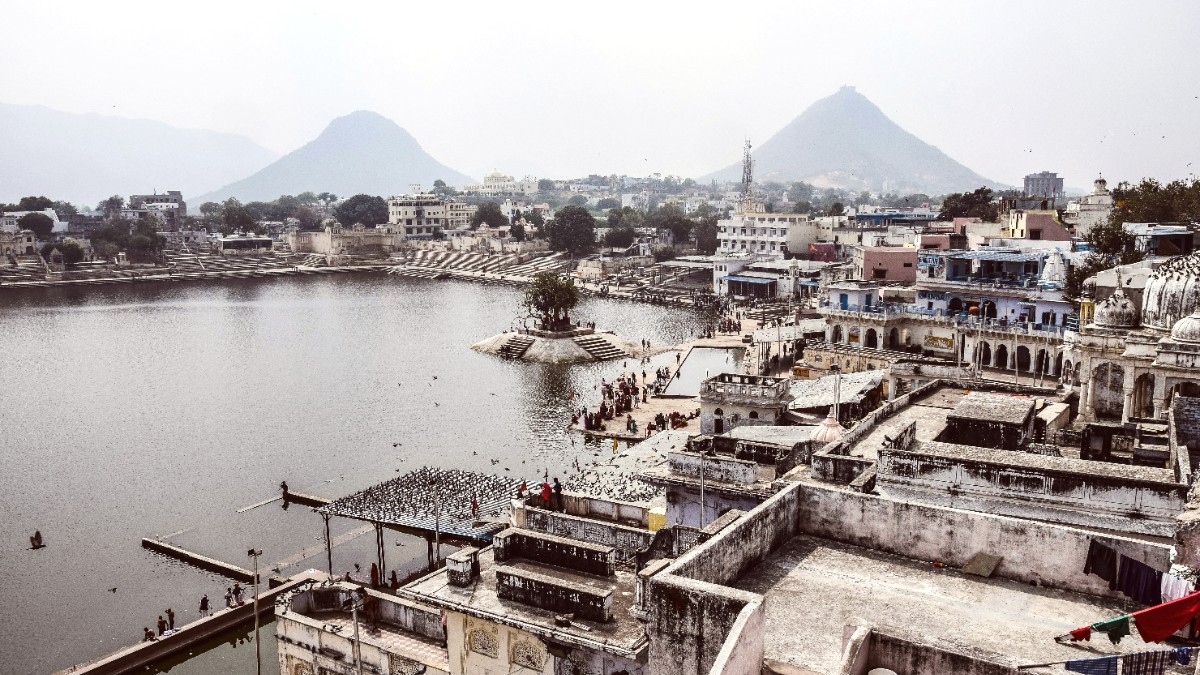
Rajasthan, India
Winter (October to March) brings the most pleasant and comfortable weather. Day temperatures are typically 15°C to 25°C (59°F to 77°F). Nights can be cool, often dropping to 5°C to 10°C (41°F to 50°F). Humidity levels are low, making outdoor activities enjoyable.
Summer (April to June) is intensely hot and dry. Day temperatures usually range from 30°C to 45°C (86°F to 113°F), often going over 40°C (104°F). Low humidity does little to soften the heat, making daytime exploration uncomfortable. Monsoon (July to September) delivers intermittent rainfall. Temperatures during this period range from 25°C to 35°C (77°F to 95°F), but humidity is high. Rainfall can vary from moderate to heavy, with August often experiencing the most precipitation.
Pushkar's tourist flow varies by season. Here's what each period brings:
(October to March)
Ideal weather for sightseeing, camel safaris, and other outdoor pursuits.
Significant crowds, especially during the Pushkar Fair. Accommodation prices are higher, and availability can be limited, calling for advance bookings.
(April, September)
Fewer crowds compared to the high season, and prices may be lower for accommodation and activities. April presents sunny days before the peak summer heat, while September shows lush, post-monsoon landscapes.
April can be very hot, making midday activities difficult. September remains humid with occasional rain, which might change outdoor plans.
(May to August)
Very few tourists, leading to significantly lower prices for accommodation and many activities. Appealing for budget-conscious travelers or those seeking a quieter experience.
Extreme heat marks the summer months, making daytime exploration uncomfortable and potentially risky without proper care. Monsoon rains can disrupt travel plans and outdoor activities in July and August.
While rain provides relief from the heat and paints the landscape green, heavy downpours can change road conditions. Outdoor activities like camel safaris might become less comfortable or temporarily unavailable during intense rain.
The summer months (May-June) feature severe heat waves. Staying adequately hydrated and using Sun protection are not just suggestions but requirements for health and comfort during this time. Avoid prolonged sun exposure during the hottest hours of the day.
Late October or early November (Kartik Purnima).
October to March (cool, dry weather).
Early mornings or late evenings (cooler, peaceful).
September presents landscapes.
May to August for fewer tourists.
Travelers to India, including Pushkar, benefit from knowing visa and entry rules for a smooth journey. Most foreign nationals need a visa before entering India.
Two main visa types are available for most visitors to India:
Gather these documents for your visa application and entry into India:
Your daily expenses will vary based on your travel style.
Estimated daily expenses based on travel style:
Daily Costs: ₹1,000 - ₹2,500 (approximately $12 - $30 USD)
Accommodation: Hostel dorm bed or basic guesthouse room (₹300-800).
Daily Costs: ₹3,000 - ₹7,000 (approximately $35 - $85 USD). Choose a comfortable mid-range guesthouse or hotel (₹1,000-3,000).
Meals: Mid-tier restaurants, rooftop cafes (₹500-1,500/day).
Transportation: Auto-rickshaws, occasional private taxi for day trips (₹200-500).
Daily Costs: ₹8,000+ (approximately $95+ USD). Stay in a boutique/heritage hotel or resort (₹4,000+).
Meals: Fine dining in hotels or upscale restaurants (₹1,500+ per meal).
Transportation: Private car with driver (₹800-2,000+ daily).
Activities: Extended camel safaris, private tours, wellness treatments (₹500-2,000+ per activity).
Value for money for memorable experiences.
Luxury travel is available with higher comforts.
| Category | Item | Price Range (INR) |
|---|---|---|
| Accommodation | Hostel dorm bed | ₹300-800 |
| Accommodation | Mid-range hotel/guesthouse | ₹1,500-3,000 |
| Meals | Basic thali/meal at local dhaba | ₹150-300 |
A few precautions contribute to handling common travel concerns effectively. Consult your doctor or a travel clinic well in advance of your trip, ideally 4-6 weeks before departure, for personalized health advice.
Yellow Fever Vaccination Certificate (if arriving from/transiting through risk countries).
Routine vaccinations (MMR, DTP, Polio, Chickenpox), Hepatitis A and B, Typhoid. Rabies and Japanese Encephalitis for prolonged stays in rural areas.
Consult a doctor 4-6 weeks before departure.
Prevention is for a healthy trip.
Traveler's Diarrhoea: Drink only sealed bottled/purified water. Avoid ice, consume hot, freshly cooked food. Peel fruits yourself.
Mosquito-borne diseases (Dengue, Malaria): Use Insect repellent containing DEET or picaridin. Wear long sleeves/pants. Sleep under mosquito nets if available.
Heatstroke/Dehydration: Stay hydrated, avoid prolonged sun exposure during peak hours. Sunburn: Use High-SPF sunscreen, Wide-brimmed hat, and Sunglasses.
Pushkar has basic clinics and pharmacies. For serious emergencies, travel to Ajmer (11-14 km away) for larger hospitals.
Police: 100 | Ambulance: 102 | Fire: 101 | All-in-one Emergency: 112 (similar to 911).
Keep emergency numbers accessible on your phone and carry copies of important documents.
Pushkar is generally safe, but awareness of common issues helps. Your personal safety and health depend on adherence to precautions.
Awareness of natural hazards and having proper insurance brings peace of mind.
Significant risk during summer (April-June). Plan activities for cooler hours; stay indoors during peak afternoon heat.
Heavy rains can lead to localized waterlogging and disrupt travel. Not severe in Pushkar itself, but nearby areas may see issues.
A comprehensive policy is highly advisable. This covers medical emergencies, evacuation, trip changes, and baggage loss. World Nomads, SafetyWing, Insubuy.